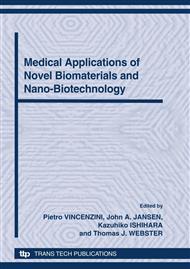p.143
p.147
p.153
p.159
p.165
p.171
p.177
p.184
p.190
XPS Characterization of Iron Oxide and Gold Nanoparticles for Tumor Care
Abstract:
Superparamagnetic iron oxide nanoparticles (SPIO) have a wide range of applications, including high-density magnetic storage, catalytic and separation processes, magnetic resonance imaging (MRI), in vivo imaging of tumor progression. One advantage is that they are sufficiently inert to be injected to the human body without significant counter effects. For these reasons, SPIO are utilized as carriers to target tumor tissues with the aim to visualize the extension of the malignant affection and to cure it. A mimetic coating is needed to overcome the immune system and ensure a sufficient long life to allow SPIO to reach the tumor tissue. In addition, gold nanoparticles were functionalized and coated with the same mimetic film. Differently from iron oxide NPs, those based on gold may be utilized to perform Surface Enhanced Raman Spectroscopy (SERS) to obtain spatial and chemical information. In this work, we present preliminary results on iron oxide and gold-based NPs synthesized in our laboratories. A full characterization was performed by means of XPS to study both the chemical composition of the SPIO nanoparticles, of their mimetic coatings, and to get structural information.
Info:
Periodical:
Pages:
165-170
Citation:
Online since:
October 2010
Price:
Сopyright:
© 2010 Trans Tech Publications Ltd. All Rights Reserved
Share:
Citation:


